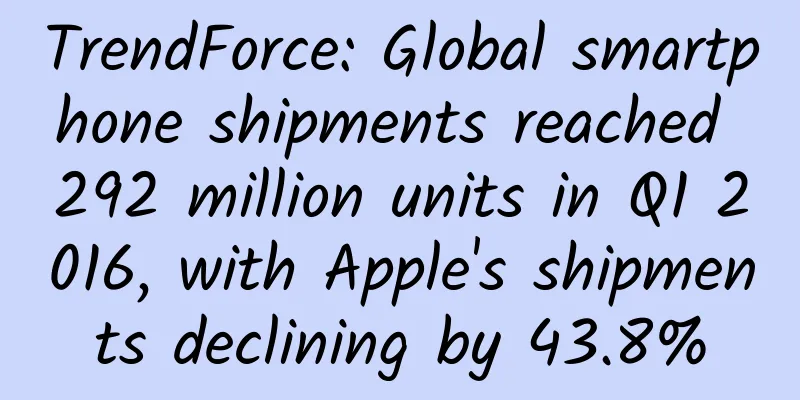TrendForce: Global smartphone shipments reached 292 million units in Q1 2016, with Apple's shipments declining by 43.8%

|
According to the latest report from TrendFroce, a global market research organization, global smartphone shipments in the first quarter of 2016 were approximately 292 million units, a decrease of 18.6% from the previous quarter and 1.3% from the previous year. The main reason is that the smartphone market is approaching saturation, and the growth momentum of leading Samsung and Apple is no longer there. The overall shipment volume can only rely on Chinese brands to increase in emerging markets such as India. TrendForce smartphone analyst Wu Yating said that in the first quarter of 2016, the total shipments of Chinese brands (including exports) surpassed the total of Samsung and Apple for the first time, reaching 125 million units, accounting for 42.9% of the global share, which continued to rise compared with 41.5% in the previous quarter. Even in the off-season, driven by two factors, operators in mainland China have increased subsidies for 4G models and actively expanded overseas markets, the shipments of Chinese brand smartphones only declined by 16% quarter-on-quarter, which is significantly smaller than other global brands. The survival space of international brand manufacturers will be further squeezed. However, due to the increasingly fierce competition in overseas markets, the profit margins of Chinese brand smartphone manufacturers are still under pressure to continue to decline. Apple iPhone SE may not be able to reverse the decline, Samsung shipments grow against the trend Apple's shipments in the first quarter dropped from 75 million units in the previous quarter to 42 million units, a quarterly decline of 43.8%, the largest quarterly decline in history. As the iPhone 6s lacked highlights and failed to further attract buyers, and Apple became more conservative in managing channel inventory before the next generation of iPhones was released, TrendForce has lowered its 2016 Apple smartphone shipment forecast to 213 million units, a decline of nearly 10% from last year. Wu Yating said that although Apple will have a low-priced iPhone SE in the second quarter, the model targets the mid-range market and as price competition among Chinese mobile phones becomes more intense, iPhone SE shipments in 2016 may be less than 15 million units, which will not be able to save the overall iPhone shipment decline this year. Samsung's smartphone shipments in the first quarter exceeded expectations, reaching 81 million units, a 2.5% quarter-on-quarter increase, mainly due to the early launch of the flagship Galaxy S7/S7 edge and strong promotional programs to attract buyers. In addition, Samsung's J (Junior) series of high-cost entry-level models have achieved good results in China and around the world. TrendForce has raised its forecast for Samsung's smartphone shipments in 2016 to 316 million units, striving to keep pace with last year's shipments. However, the increase in shipments means that Samsung has adopted a strategy of compressing profit margins to maintain its market share, and there may be a trend of slightly declining gross profit margins in subsequent quarters. Compared to other mobile phone manufacturers, LG has been making every effort to innovate its mobile phones. From the first 2K screen released in G3 to the use of a message bar screen above the main screen in V10, the G5 released at MWC this year pioneered a modular design, allowing users to enhance the functions of the mobile phone according to their own needs, such as battery, camera, and music. However, surrounded by strong competitors, LG's shipments in the first quarter still declined slightly, and its market share remained at the sixth position. Huawei remains the leading smartphone brand in China and continues to narrow the gap with Apple Huawei's shipments in the first quarter reached 27 million units. Despite a quarterly decline of about 20%, it still maintained its position as the third largest in the world and the first in China. Huawei's HiSilicon Kirin series chips can compete with high-end products from Qualcomm and MediaTek, making Huawei the largest, most technologically advanced, most fully integrated upstream and downstream Chinese mobile phone manufacturer with the least resistance to overseas shipments. Wu Yating said that Huawei can continue to maintain its market share in China, but it will not replace Apple as the second in the world, but the gap between the two is expected to narrow year by year. Lenovo shipped 17 million units in the first quarter, a quarterly decline of only 5.6%. Lenovo's strategy this year has shifted to overseas shipments, planning that overseas sales will account for 80% of total shipments, and market share in Indonesia, India and other countries will exceed 10%. However, Lenovo's products have not been successfully differentiated, and its flagship phones lack highlights, which have failed to arouse widespread discussion among consumers, and its market share may continue to decline in the future. Xiaomi shipped about 16 million units in the first quarter, continuing to compete with Lenovo for the second largest Chinese smartphone brand. Wu Yating pointed out that Xiaomi's smartphones are highly talked about, such as the Xiaomi 5, which uses Qualcomm's top chip Snapdragon 820, up to 4GB of LPDDR4 memory and up to 128GB of storage space, which are all top choices at this stage. In addition, Xiaomi is committed to the establishment of the Internet of Things and the ecosystem. Although smartphone shipments may only grow slightly this year, the benefits of its peripheral products are still expanding. OPPO and vivo are expected to have a combined share of nearly 20% in China this year. Vivo launched the world's first Xplay5 with 6GB of memory and a dual-curved screen, showing its sincerity in hardware specifications. In addition to maintaining sales channels in China's second- and third-tier cities, vivo's overseas market share has expanded to 10%. OPPO focuses on all-round functionality, such as high-quality camera functions and fast charging, but it traditionally uses mid-range application processors and is good at using system optimization strategies to achieve a balance between user experience. OPPO is an early Chinese brand to explore overseas markets and has achieved good sales in Southeast Asia, India and other markets. |
>>: These 20 "health care" suggestions are all wrong, don't be misled anymore!
Recommend
If there is a lot of foam in the urine, could it be a sign of kidney disease?
Foamy urine has long been considered an important...
Will multiple medical abortions make the vagina looser and larger?
The vagina is the most important part of a woman&...
What are the risks of induced abortion at four and a half months of pregnancy?
Induced abortion is a method used when there is n...
Can I soak my feet during my period?
For women, maintenance during the menstrual perio...
Is it normal to have a period every 26 days?
In daily life, most girls often have irregular me...
If I take my baby home for the New Year, can I get the vaccine in advance?
The Spring Festival is coming soon! Many parents ...
How can women avoid pregnancy without IUD?
The intrauterine device (IUD) is a common contrac...
Love = 6 bottles of wine? But I still want to fall in love after drinking...
Follow "Body Code Decoding Bureau" (pub...
Anti-aging medicinal diet revealed, five recipes for anti-aging
Since ancient times, longevity has been a goal pu...
Does ovarian cyst surgery affect pregnancy?
Ovarian cysts are a common condition in women. Ov...
How many days does the actual ovulation period last?
For normal female friends of childbearing age, th...
What kind of door is better to install between the living room and the balcony? How to make the door between the living room and the balcony look good?
We all know that the living room and balcony are ...
What to do if a woman has pain on the left side of her abdomen
Pain on the left side of the abdomen is something...
Acne on face after pregnancy
It is a girl's nature to love beauty. Even wh...









